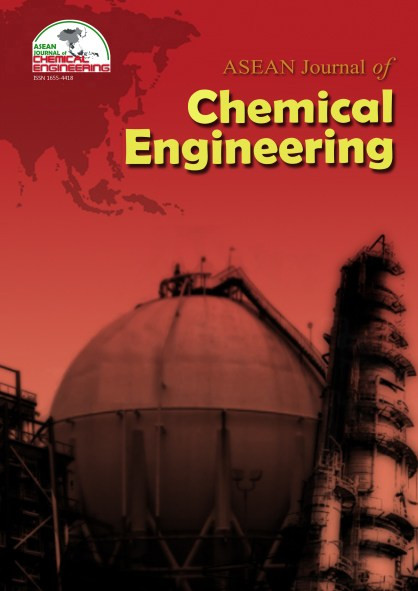Mathematical Model for Water Flooding and HPAM Polymer Flooding in Enhanced Oil Recovery
Abstract
The need for energy, especially the petroleum-based one, is steadily increasing along with population growth and technological advancement. Meanwhile, oil exploitation from oil reservoirs using primary and secondary techniques can only obtain about 30%-50 % out of the original oil in place. Enhanced Oil Recovery (EOR) is a method for increasing oil recovery from a reservoir by injecting materials that are not found in the reservoir, such as surfactant, polymer, etc. This research aims to develop a mathematical model representing two-phase flow through porous media in the EOR process. This model was extended from mass balance and fluid flow in porous media equations. The reliability of the model was then validated by water flooding and polymer flooding experiment. A porous media, constituted by a silica sand pack, was saturated with 2 % brine and sequentially flooded with HPAM polymer solution at various concentrations (5,000-15,000 ppm). The volume of the oil coming out from the media at any time intervals was measured. Validation of the model was carried out by optimizing the model parameters to obtain the best curve-fitting on the plot of the percentage of cumulative recovered oil against time. The results showed that the proposed mathematical model was reliable enough to express both water and polymer-flooding processes.
References
2. Borazjani, S., Bedrikovetsky, P., and Farajzadeh, R. (2016). "Analytical solutions of oil displacement by a polymer slug with varying salinity," J. Pet. Sci. Eng., 140, 28–40
3. Budiaman, I. G. S. (1994). One-dimensional two-phase flow on enhanced oil recovery using immiscible chemical flooding (In Bahasa Indonesia), Thesis, Department of Chemical Engineering, Gadjah Mada University, Yogyakarta, Indonesia.
4. British Petroleum. (2018). BP Statistical Review of World Energy; June 2018.
5. Dang, T. Q. C., Chen, Z., Nguyen, T. B. N., and Bae, W. (2015). "Rheological Modeling and Numerical Simulation of HPAM Polymer Viscosity in Porous Media," Energy Sources, Part A: Recovery, Utilization, and Environmental Effects, 37:20, 2189–2197.
6. Davarpanah, A. and Mirshekari, B. (2019). "A mathematical model to evaluate the polymer flooding performances," Energy Reports, 5, 1651–1657.
7. Firozjaii, A. M., Akbari, M., and Zargar, G. (2019).” Sensitivity analysis and optimization on effective parameters during chemical enhanced oil recovery (CEOR) using experimental design and numerical simulation," Energy Sources, Part A: Recovery, Utilization, and Environmental Effects, 41:15, 1847–1861.
8. Hasegawa, M., Furuno, A., Ishikawa, H., and Ogawa, Y. (1976). U. S. Pat. 3 986 093.
9. Hatzignatiou, D. G., Norris, U. L., and Stavland, A. (2013). "Core-scale simulation of polymer flow through porous media," J. Pet. Sci. Eng., 108, 137–150.
10. Kirk, G. W., and Othmer, D. F. (2007). Encyclopedia of chemical technology, 5th edition, John Wiley and Sons, New York, U. S. A.
11. Lake, L. W., Johns, R., Rossen, B., and Pope, G. (2014). Fundamentals of Enhanced Oil Recovery, Society of Petroleum Engineers,TX, USA
12. Noraishah, Saaid, I. M., Ahmed, A., Yusof, N. H., Yahya, R., Yunos, M. A. S. M., Chik, E. M. F. E., Shari, M. R., Hassan, H., and Mahmood, A. A. (2020). "Investigation of Water-Flooding Activity Using Radiotracer Technology in Commercial Core-Flood Set Up," ASEAN J. Chem. Eng., 20(1), 49–56.
13. Pope, G. A. (2007). Overview of chemical EOR, Casper EOR Workshop, The University of Texas, Austin, U. S. A.
14. Rellegadla, S., Prajapat, G., and Agrawal, A. (2017). "Polymers for enhanced oil recovery: fundamentals and selection criteria," Appl Microbiol Biotechnol, 101, 4387–4402.
15. Vicente, B.J., Priimenko, V.I., and Pires, A.P. (2020). "Mathematical Model of Water Alternated Polymer Injection." Transp Porous Med., 135, 431–456.
16. Wang, J., Liu, H.Q., and Xu, J. (2013). "Mechanistic Simulation Studies on Viscous-Elastic Polymer Flooding in Petroleum Reservoirs," J. Dispersion Sci. Technol., 34:3, 417–426.
17. Wang, D., Xia, H., Liu, Z., and Yang, Q. (2001, April 17-19). "Study of the mechanism of polymer solution with visco-elastic behavior increasing microscopic oil displacement efficiency and the forming of steady "oil thread" flow channels." SPE - Asia Pacific Oil and Gas Conference, Jakarta, Indonesia.
18. Xia, H., Ju, Y., Kong, F., and Wu, J. (2004, September 26-29). "Effect of elastic behavior of HPAM solutions on displacement efficiency under mixed wettability conditions." SPE - Annual Technical Conference and Exhibition, Houston, Texas, U. S. A.
19. Yin, H., Wang, D., and Zhong, H. (2006, September 24-27). "Study on flow behaviors of viscoelastic polymer solution in micropore with dead end." SPE - Annual Technical Conference and Exhibition, San Antonio, Texas, U. S. A.
20. Zhang, L., Yue, X., and Guo, F. (2008). "Micro-mechanisms of residual oil mobilization by viscoelastic fluids," Pet. Sci., 5, 56–61.
Copyright holder for articles is ASEAN Journal of Chemical Engineering. Articles published in ASEAN J. Chem. Eng. are distributed under a Creative Commons Attribution-NonCommercial 4.0 International (CC BY-NC 4.0) license.
Authors agree to transfer all copyright rights in and to the above work to the ASEAN Journal of Chemical Engineering Editorial Board so that the Editorial Board shall have the right to publish the work for non-profit use in any media or form. In return, authors retain: (1) all proprietary rights other than copyright; (2) re-use of all or part of the above paper in their other work; (3) right to reproduce or authorize others to reproduce the above paper for authors’ personal use or for company use if the source and the journal copyright notice is indicated, and if the reproduction is not made for the purpose of sale.



